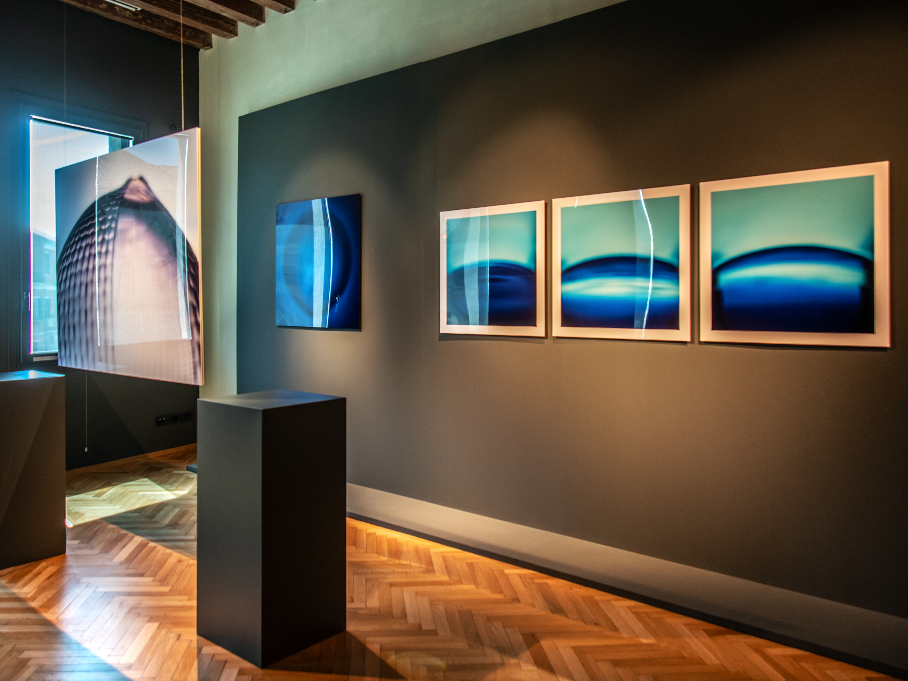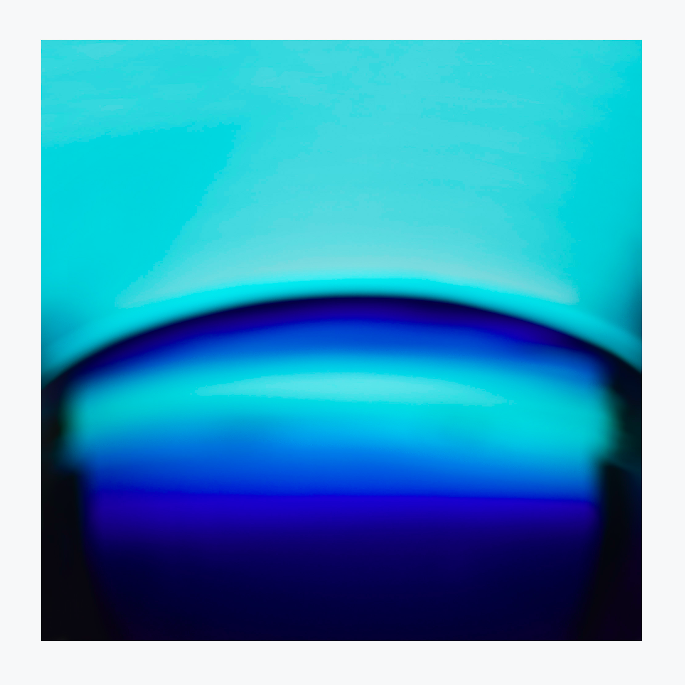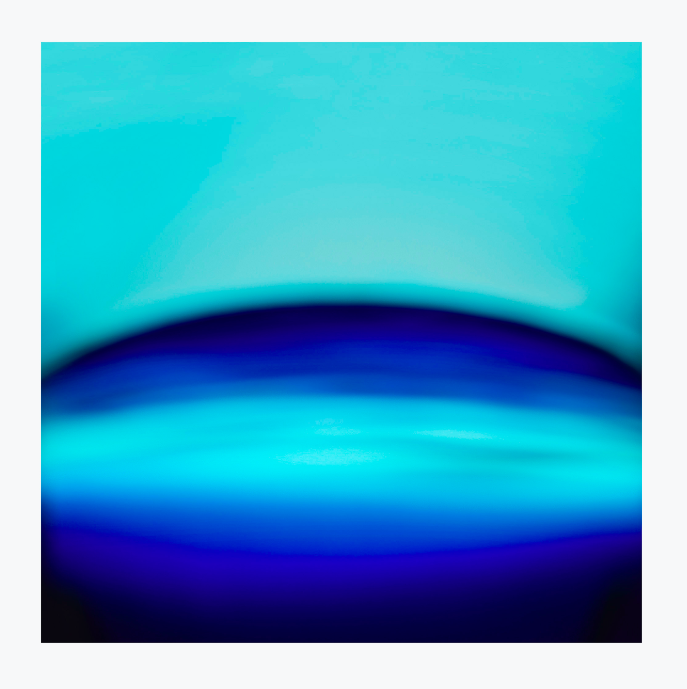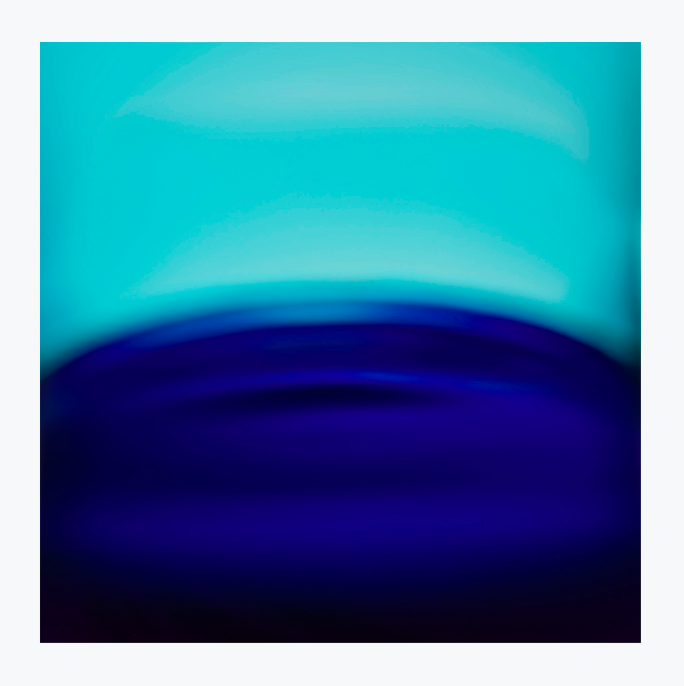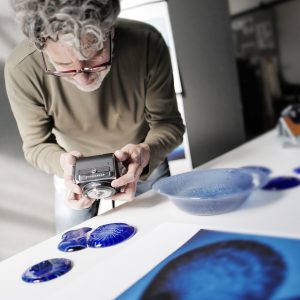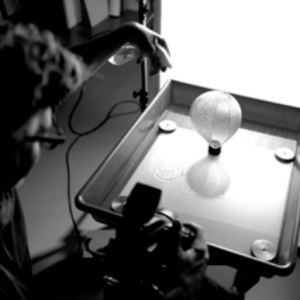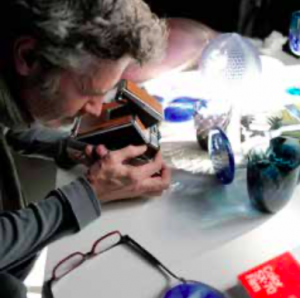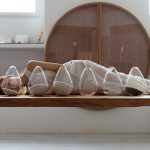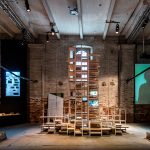english below
Curato da Roberta Orio, “Murano in Focus” è un progetto espositivo che documenta attraverso un fermo immagine fotografico – un tempo chiamato reportage, fotografia industriale, still-life – l’identità di Murano oggi attraverso le immagini che “l’isola del vetro” è capace di provocare.
Æ – Assieme a Roberta Orio e Luigi Bussolati, sei stato chiamato per interpretare l’identità di Murano. Qual’è stato il tuo primo pensiero e come ti sei approcciato a questo progetto corale?
MG – La curatrice Orio mi aveva chiesto di indagare l’acqua come elemento che circonda l’isola di Murano. Il mio rapporto “fotografico” con il mare è un amore recente, la mia ricerca con i #piccolimaritascabili, che è un progetto nato su Instagram e diventato poi altro, non poteva essere la chiave di lettura per Murano in Focus. Nel cercare il nuovo approccio che dovevo avere con l’elemento “acqua” sono tornato alle origini. Il mio habitat naturale è la sala posa, è lì che mi sento a mio agio, lo still life da sempre guida il mio sguardo e il mio lavoro si muove intorno all’interpretazione di oggetti di design. La sfida a questo punto è diventata far incontrare mondi lontani, la natura e la tecnica, svelando elementi evocativi all’interno di oggetti così solidi e reali.
“Ci sono luoghi che raccontano storie di vite, che concedono sottili letture, che fanno sognare. Murano è uno di questi. Ecco allora che nasce questo progetto, entro il quale gli autori sono chiamati a dare vita a ciò che per una consuetudine dello sguardo non vediamo più, per regalarcelo nuovamente. La domanda quindi è: quello che non vediamo, esiste?” – Roberta Orio
Æ – Rubo la domanda fatta da Roberta : “quello che non vediamo esiste?” Tu, cosa vedi? E cosa decidi di farci vedere?
MG –Per creare le mie opere ho voluto far vedere quello che esiste ma che è celato, nascosto da trame che sembrano intellegibili. Ho scelto di cercare e mostrare l’acqua tra le tracce dei meravigliosi manufatti creati nelle vetrerie di Murano da che l’isola esiste. Volevo raccontare la storia di Murano attraverso le piccole architetture di vetro che conservano il respiro di artigiani straordinari, che con la loro creatività, sofferenza e maestria lasciano la loro anima custodita in questi scrigni magici. Se ti fermi a osservarli e lasci attraversare la luce tra le anse ne percepisci il movimento. Ho voluto cristallizzare quegli attimi. Con la lente d’ingrandimento mi sono immerso nelle profondità più blu, mi sono spinto tra le cellule del vetro alla ricerca della goccia primordiale, ho voluto glorificare le grandi Cattedrali come architetture eterne.
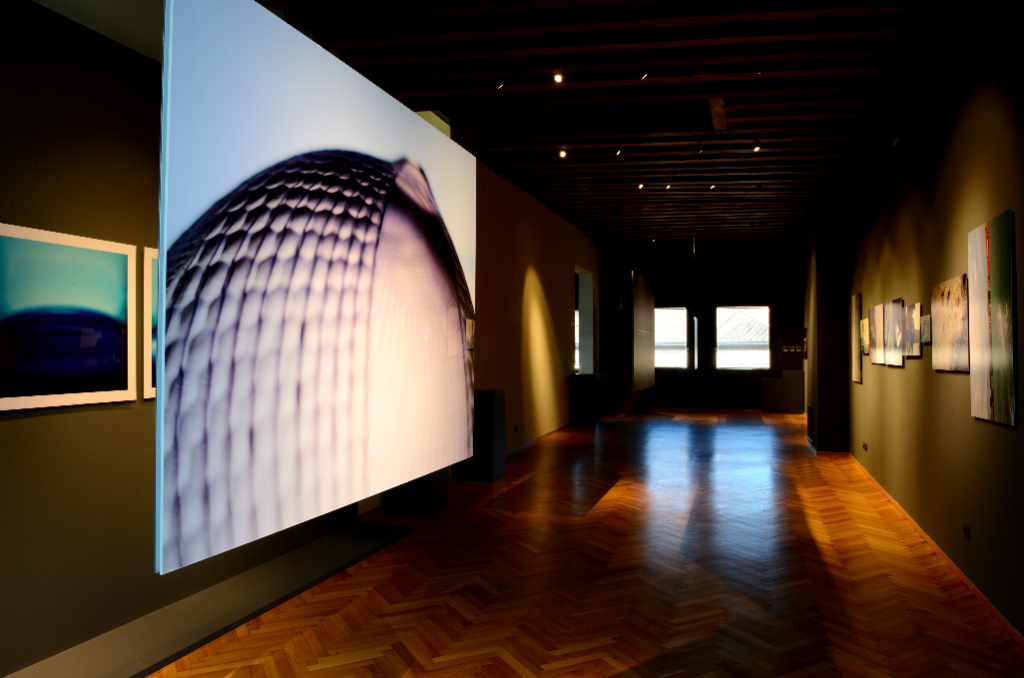
ph. Roberta Orio
Æ – Un tuffo tra superfici cerulee, blu, azzurre, pervinca… limpide eppure dense.
La tua è una Murano inusuale, fortemente astratta, che sembra materializzarsi non appena viene contestualizzata mediante concetti come il rapporto tra Murano, il vetro, l’acqua e l’aria.
Com’è stata questa esperienza e come si è svolto il tuo processo di ricerca? Da dove sei partito e perché hai deciso di rappresentare le “tracce d’acqua nel soffio dei grandi maestri”? Chi sono i maestri?
MG – Negli Overglass ho voluto cercare l’orizzonte della laguna tra le vibrazioni dei blu. Con la Nascita mi sono spinto all’interno della goccia generatrice. Infine la grande Cattedrale che ci accoglie nel suo ventre. I maestri vetrai, sono loro, che riescono a portarci in universi altri, trasformano la sabbia in vetri trasparenti, il colore si fonde nella materia come non siamo abituati a vedere. Custodiscono i segreti alchemici di incantevoli evoluzioni e i saperi di un mestiere antico, quando li vedi al lavoro rimani completamente rapito dall’eleganza dei loro sapienti movimenti ancestrali.
AE – Per questa esposizione, le foto backstage e del making of, ti ritraggono con tra le mani oggetti affascinanti di rara bellezza – e non sto parlando solo dei vetri artistici che poi hai fotografato – ma anche degli strumenti scelti per realizzare i tuoi scatti, Hasselblad e una SX 70.
Sei sempre analogico? Cosa porta questa scelta al tuo lavoro e quanto questo tipo di fotografia influisce sullo scatto finale e di conseguenza sul linguaggio visivo da te rappresentato?
MG – Non sono un nostalgico della pellicola, mi piace utilizzare il dorso digitale Hasselblad utilizzando il foro stenopeico al posto dell’ottica. Amo la pastosità cromatica della Polaroid. Scelgo questi strumenti a seconda di quello che voglio ottenere. Anche se hanno quei tratti vintage che mi riportano ai miei inizi, cerco di non lasciarmi sedurre dall’oggetto fotografico.
Æ – Niente è stato lasciato al caso, infatti diversa è anche la scelta di stampare il tuo lavoro su una superficie specchiante, più precisamente di vetro acrilico, che riflette l’osservatore all’interno dell’opera stessa. Un ulteriore strato simbolico da decifrare?
MG – In Overglass e nella Nascita, volevo ritrovare quell’effetto di specchiatura sulla superficie dell’acqua, dove a seconda di cosa metti a fuoco vedi la profondità del mare o la tua immagine riflessa, in un continuo equilibrio, dentro e fuori dall’opera. Questo effetto l’ho ritrovato nella sofisticata stampa a sublimazione direttamente su alluminio. La superficie vetrificata, leggermente irregolare ci restituisce la magia del pelo d’acqua.
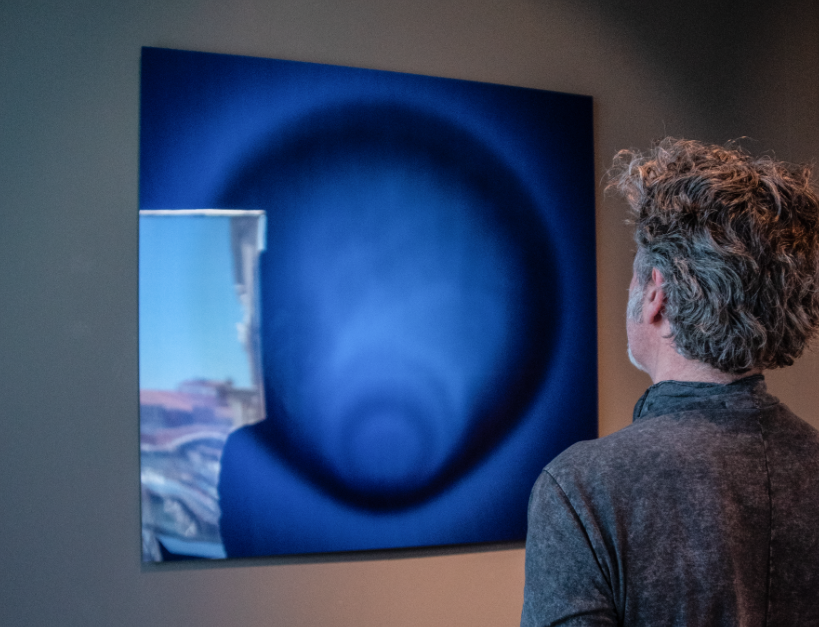
Æ – Infine, pensi questa mostra e che la vostra visione creativa abbia effettivamente riportato il Focus su Murano? Se sì, in che modo?
MG – Non posso essere io a giudicare se l’obiettivo sia stato raggiunto, ma penso che connettere e far dialogare tre sguardi, tre modi di raccontare e tre diversi aspetti di Murano possa far emergere l’anima poliedrica e versatile di quest’isola. Che per sua natura è staccata dal resto del mondo ma allo stesso tempo ne è stata centro artistico e di grandi saperi e ancora oggi mantiene la sua anima viva grazie a chi l’ha resa grande e a chi ha scelto di continuare a farne e raccontarne la storia.
Murano in Focus
***
Curated by Roberta Orio, “Murano in Focus” is a photographic project documenting through still photographic images — formerly called reportage, industrial photography, still-life — the identity of Murano today through the images that “the island of glass” is capable of eliciting.
Æ – Together with Roberta Orio and Luigi Bussolati, you have been called upon to interpret the identity of Murano. What was your first thought and how did you approach this group project?
MG – The curator Orio asked me to investigate water as the element that surrounds the island of Murano. My “photographic” relationship with the sea is a recent love, my research with #piccolimaritascabili, which is a project born on Instagram which then transformed into something else, could not be the interpretation for Murano in Focus. In looking for the new approach I had to find for the element of “water”, I went back to basics. My natural habitat is the studio, that’s where I feel at ease, still life has always guided my vision and my work revolves around the interpretation of design objects. The challenge at this point has become bringing together distant worlds, nature and technology, revealing evocative elements within such solid and real objects.
“There are places that recount life stories, that grant subtle readings, that make you dream. Murano is one of these. This is how this project was born, within which the creators are called to give life to what we no longer see with our habitual gaze, to return it to us. The question therefore is: does what we do not see exist?” – Roberta Orio
Æ – I steal Roberta’s question: “Does what we don’t see exist?” You, what do you see? And what do you decide to show us?
MG – To create my works I wanted to show that which exists but is concealed, hidden by tales that we appear to understand. I chose to look for and show water among the traces of the wonderful artefacts that have been created in Murano glass factories ever since the island has existed. I wanted to tell the story of Murano through the small glass creations that preserve the breath of extraordinary artisans, who with their creativity, suffering and mastery leave their soul preserved in these magical treasures. If you stop to observe them and watch the light looping through them, you can perceive their movement. I wanted to crystallize those moments. With my magnifying glass I plunged into the bluest depths, I pushed between the cells of the glass in search of the primordial drop; I wanted to glorify these great cathedrals as eternal architectures.

ph. Roberta Orio
Æ – A dip between cerulean, blue, azure, periwinkle surfaces … clear yet dense.
Yours is an unusual, highly abstract Murano, which seems to materialize as soon as it is contextualized through concepts such as the relationship between Murano, glass, water and air.
How did you find this experience and how did your research process go? Where did you start from and why did you decide to represent the “traces of water in the breath of the great masters”? Who are the masters?
MG – In Overglass I wanted to look at the horizon of the lagoon among the blue vibrations. With Nascita I pushed myself inside the generating bubble. Finally, the great Cathedral that welcomes us into its womb. The glass masters are those who can take us to other worlds, transform sand into transparent glass, blend colour into their material in ways we are not used to seeing. They guard the alchemical secrets of enchanting evolutions and the knowledge of an ancient craft, when you watch them at work you are completely captivated by the elegance of their masterly traditional movements.
AE – For this exhibition, the backstage and making-of photos portray you with fascinating objects of rare beauty in your hands – and I’m not just talking about the artistic glass that you’ve photographed – but also the tools chosen to take your shots, the Hasselblad and SX 70.
Are you always analogue? What does this choice bring to your work and how much does this type of photography affect the final shot and consequently the visual language you represent?
MG – I’m not nostalgic for film, I like to use the Hasselblad digital back using the pinhole instead of the lens. I love the chromatic softness of Polaroid. I choose these tools depending on what I want to achieve. Even if they have those vintage features that take me back to my beginnings, I try not to let myself be seduced by the photographic device.
Æ – Nothing has been left to chance; in fact the choice of printing your work on a mirrored surface, in acrylic glass to be exact, is also different, reflecting the observer within the work itself. An additional symbolic layer to decipher? MG –
MG – In Overglass and in Nascita, I wanted to rediscover that mirror effect on the surface of the water, where depending on where you focus you can see the depth of the sea or your reflected image, in a continuous balance, both inside and outside the work. I was able to replicate this effect in the sophisticated sublimation of printing directly onto aluminium. The glazed, slightly irregular surface recreates the magic of the surface of the water.

Æ – Finally, do you think that this exhibition and your creative vision have actually brought the Focus back to Murano? If so, how?
MG – I can’t be the one to judge if the goal has been achieved, but I think that connecting and making three visions, three ways of recounting and three different aspects of Murano, can bring out the multifaceted and versatile soul of this island. That is naturally separated from the rest of the world, but at the same time has been a centre for art and for great knowledge; and which still retains its soul thanks to those who made it great and to those who chose to continue to create and to tell its story.

